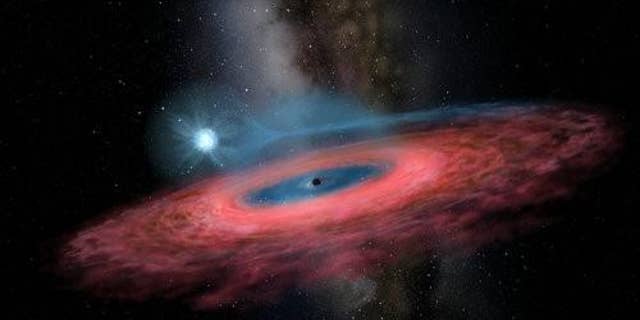Scientists have discovered a huge black hole that is challenging long-held assumptions about the cosmic bodies in the Milky Way.
Stellar black holes are formed by the collapse of massive stars. The mass of an individual stellar black hole in our galaxy has long been estimated to be no more than 20 times that of the Sun, according to researchers.
Now, however, an international team of scientists led by Prof. Liu Jifeng of the National Astronomical Observatory of China of the Chinese Academy of Sciences (NAOC), has discovered a monster stellar black hole with a mass 70 times greater than the Sun.
FIRST-EVER BLACK HOLE IMAGE REVEALED
"Black holes of such mass should not even exist in our Galaxy, according to most of the current models of stellar evolution," said Prof. Liu, in a statement.

Artist's impression of LB-1. (Yu Jingchuan, Beijing Planetarium, 2019)
"We thought that very massive stars with the chemical composition typical of our Galaxy must shed most of their gas in powerful stellar winds, as they approach the end of their life,” Liu added. “Therefore, they should not leave behind such a massive remnant. LB-1 is twice as massive as what we thought possible. Now theorists will have to take up the challenge of explaining its formation."
The black hole, named LB-1, is 15,000 light-years away. A light-year, which measures distance in space, equals 6 trillion miles.
3 BLACK HOLES POSSIBLY SEEN COOKING THEIR GALAXIES ALIVE
A paper on the discovery has been published in the journal Nature.
Researchers made the discovery using China’s Large Sky Area Multi-Object Fiber Spectroscopic Telescope (LAMOST). The telescope looks for stars that orbit an invisible object, pulled by its gravity, according to the scientists. Previously, stellar black holes could only be discovered by identifying X-ray emissions created when they devoured gas from a companion star.
After the black hole was spotted using LAMOST, the Gran Telescopio Canarias in Spain and the Keck I telescope in the U.S. were used to establish its physical parameters.
DISTANT ALIEN PLANET WITH THREE RED SUNS DISCOVERED
In the statement, experts note that the discovery of LB-1” fits nicely” with another breakthrough in astrophysics – the detection of ripples in space-time caused by black hole collisions in distant galaxies. The ripples have been identified by the Laser Interferometer Gravitational-Wave Observatory (LIGO) in the U.S. and the Virgo gravitational wave detector in Italy.
"This remarkable result along with the LIGO-Virgo detections of binary black hole collisions during the past four years really points towards a renaissance in our understanding of black hole astrophysics," said LIGO Director Prof. David Reitze of the University of Florida, in the statement.
Earlier this year, in a separate project, scientists released the first-ever image of a black hole, revealing the distant object in stunning detail.
The groundbreaking image was captured by the Event Horizon Telescope, an international project involving telescopes across the globe that describes itself as a “virtual Earth-sized telescope.” Telescopes in Hawaii, Arizona, Chile, Mexico, Spain and the South Pole participated in the ambitious research project.
CLICK HERE TO GET THE FOX NEWS APP
The black hole in question was spotted in galaxy Messier 87 (M87) that is 55 million light-years away.
Follow James Rogers on Twitter @jamesjrogers
https://news.google.com/__i/rss/rd/articles/CBMiRmh0dHBzOi8vd3d3LmZveG5ld3MuY29tL3NjaWVuY2UvZ2lhbnQtYmxhY2staG9sZS1zaG91bGQtbm90LWV2ZW4tZXhpc3TSAUpodHRwczovL3d3dy5mb3huZXdzLmNvbS9zY2llbmNlL2dpYW50LWJsYWNrLWhvbGUtc2hvdWxkLW5vdC1ldmVuLWV4aXN0LmFtcA?oc=5
2019-11-29 16:11:25Z
52780451885630
Tidak ada komentar:
Posting Komentar